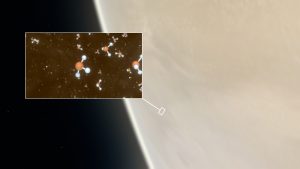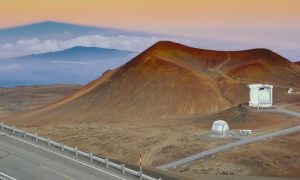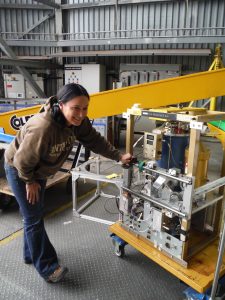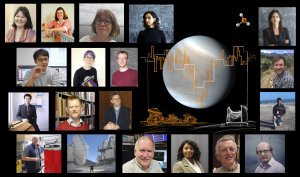An international team of astronomers, led by Professor Jane Greaves of Cardiff University, UK, today announced the discovery of a rare molecule – phosphine – in the clouds of Venus. On Earth, this gas is only made industrially, or by microbes that thrive in oxygen-free environments. The detection of phosphine could point to such extra-terrestrial “aerial” life. “When we got the first hints of phosphine in Venus’s spectrum, it was a shock!”, said Jane, who first spotted signs of phosphine in observations from the James Clerk Maxwell Telescope (JCMT) in Hawai`i.
Astronomers have speculated for decades that high clouds on Venus could offer a home for microbes – floating free of the scorching surface, with access to water and sunlight, but needing to tolerate very high acidity. The detection of phosphine, which consists of hydrogen and phosphorus, could point to this extra-terrestrial ‘aerial’ life. The new discovery is described in a paper published today in Nature Astronomy.

Artistic impression of Venus depicting a representation of phosphine molecule shown in the inset. The molecules were detected in the Venusian high clouds in data from the James Clerk Maxwell Telescope and the Atacama Large Millimeter/submillimeter Array. Astronomers have speculated for decades that life could exist in Venus’s high clouds. The detection of phosphine could point to such extra-terrestrial “aerial” life. Image credit: ESO/M. Kornmesser/L. Calçada & NASA/JPL/Caltech.
The first detection of phosphine in the clouds of Venus was made using the JCMT in Hawai`i. The team were then awarded time to follow up their discovery with 45 telescopes of the Atacama Large Millimeter/submillimeter Array (ALMA) in Chile. Both facilities observed Venus at a wavelength of about 1 millimetre, much longer than the human eye can see – only telescopes at high altitude can detect it effectively. “In the end, we found that both observatories had seen the same thing — faint absorption at the right wavelength to be phosphine gas, where the molecules are backlit by the warmer clouds below” said Jane.
The astronomers then ran calculations to see if the phosphine could come from natural processes on Venus. Massachusetts Institute of Technology scientist Dr William Bains led the work on assessing natural ways to make phosphine. Some ideas included sunlight, minerals blown upwards from the surface, volcanoes, or lightning, but none of these could make anywhere near enough of it. Natural sources were found to make at most one ten thousandth of the amount of phosphine that the telescopes saw. In contrast the team found that in order to create the observed quantity of phosphine on Venus, terrestrial organisms would only need to work at about 10% of their maximum productivity. Any microbes on Venus will though likely be very different to their Earth cousins. Earth bacteria can absorb phosphate minerals, add hydrogen, and ultimately expel phosphine gas.
Team member and MIT researcher, Dr Clara Sousa Silva, had thought about searching for phosphine as a ‘biosignature’ gas of non-oxygen-using life on planets around other stars, because normal chemistry makes so little of it. She comments “Finding phosphine on Venus was an unexpected bonus! The discovery raises many questions, such as how any organisms could survive. On Earth, some microbes can cope with up to about 5% of acid in their environment – but the clouds of Venus are almost entirely made of acid.”
The team believes this discovery is significant because they can rule out many alternative ways to make phosphine, but they acknowledge that confirming the presence of “life” needs a lot more work. Although the high clouds of Venus have temperatures up to a pleasant 30 degrees centigrade, they are incredibly acidic – around 90% sulphuric acid – posing major issues for microbes to survive there. Prof Sara Seager and Dr Janusz Petkowski, both at MIT, are investigating how microbes could shield themselves inside scarce water droplets.
The team are now eagerly awaiting more telescope time to establish whether the phosphine is in a relatively temperate part of the clouds, and to look for other gases associated with life. This result also has implications in the search for life outside our Solar system.
On hearing the results of the JCMT study, the JCMT’s Deputy Director Dr Jessica Dempsey said “These results are incredible” and went on to say “this discovery made in Hawai`i, by the JCMT, was made with a single pixel instrument. This is the very same instrument that also took part in capturing the first image of a Black Hole, Pōwehi. The discovery of phosphine in the atmosphere of Venus really showcases the breadth of cutting-edge research undertaken by astronomers using the JCMT. I am so pleased of the efforts from all our staff here in Hawai`i”

JCMT, seen with its white iconic Gore-Tex membrane, open for morning observing. The shadow of Maunakea rises over Hualālai in the distance. JCMT is able to observe during the daytime as it operates at sub-millimeter wavelengths. Image credit: Tom Kerr, UKIRT.
Former UH Hilo astronomy student, E’Lisa Lee who took some of the JCMT data during her time working as a part-time JCMT telescope operator summed up her feelings “An observed biochemical process occurring on anything other than Earth has the greatest and most profound implications for our understanding of life on Earth, and life as a concept.” Adding “Being able to participate in the scientific process, as an operator at JCMT was an incredible and humbling experience. It is my sincerest hope that further observations will allow for greater exploration of Venusian clouds and everything beyond.” E’Lisa currently studying for her Master’s degree in physics at Fresno State University.
The JCMT instrument that captured this phosphine discovery has since retired and been replaced by a new and more sensitive instrument known as Nāmakanui. On the potential of this new instrument, Jessica commented “Like it’s namesake, the big-eyed fish hunting food in the dark waters, we will turn the far more sensitive Nāmakanui back to Venus in this hunt for life in our universe. This is just the beginning, and I’ve never been more excited to be a part of our boundary-pushing JCMT team.”

JCMT Deputy Director, Jessica Dempsey stands beside the now retired instrument, RxA3m, that made this first detection of phosphine on Venus. The instrument has since been replaced by a more powerful instrument called Nāmakanui. Image Credit: Harriet Parsons.
Supplemental Information
This research was presented in the paper “Phosphine Gas in the Cloud Decks of Venus” published in Nature Astronomy. A copy of the paper will be available with free access from www.nature.com/articles/s41550-020-1174-4. Further information and resources can be found at: maunakeaobservatories.org/venusnews/
Video assets and additional information available on the Maunakea Observatories website.
Previous papers discussing the nature of phosphine and life on Venus:
- The Venusian Lower Atmosphere Haze as a Depot for Desiccated Microbial Life: A Proposed Life Cycle for Persistence of the Venusian Aerial Biosphere, Sara Seager, Janusz J. Petkowski, Peter Gao, William Bains, Noelle C. Bryan, Sukrit Ranjan and Jane Greaves, Astrobiology 2020.
- Phosphine as a Biosignature Gas in Exoplanet Atmospheres, Calar Sousa-Silva, Sara Seager, Sukrit Ranjan, Janusz Jurand Petowski, Zhuchang Zhan, Renyu Hu, and William Bains , Astrobiology VOL. 20 NO. 2 2020
The team is composed of: Jane S. Greaves (Cardiff University, UK), Anita M. S. Richards (Jodrell Bank Centre for Astrophysics, The University of Manchester, UK), William Bains (MIT, USA), Paul Rimmer (Department of Earth Sciences and Cavendish Astrophysics, University of Cambridge and MRC Laboratory of Molecular Biology, Cambridge, UK), Hideo Sagawa (Kyoto Sangyo University, Japan), David L. Clements (Imperial College London, UK), Sara Seager (MIT, USA), Janusz J. Petkowski (MIT, USA), Clara Sousa-Silva (MIT), Sukrit Ranjan (MIT), Emily Drabek-Maunder (Cardiff and Royal Observatory Greenwich, UK), Helen J. Fraser (The Open University, UK), Annabel Cartwright (Cardiff University, UK), Ingo Mueller-Wodarg (Imperial College, UK), Zhuchang Zhan (MIT, USA), Per Friberg (EAO/JCMT), Iain Coulson (EAO/JCMT), E’Lisa Lee (EAO/JCMT) and Jim Hoge (EAO/JCMT).
`Ōlelo Hawai`i
A copy on the Press Release in `ōlelo Hawai`i is provided here.
Makaola
Dr. Larry Kimura, Associate Professor University of Hawaii, Hilo in the Ka Haka ʻUla O Keʻelikōlani, College of Hawaiian Language was asked to provide assistance with the translation of the news of the detection of phosphine into `ōlelo Hawai`i. The translatio required Dr Kimura to create a new word to describe the possibility of the detection of life. In the process Makaola – a detection of life – was formed.
Maka is the basic word for “eye” and in Hawaiian the nuances or other meanings go on; kūmaka-visible, seen; makaʻala-alert, watchful; makamua-the very first; etc. Also as used in the Kumulipo when we see “maka liʻi” or tiny eyes, those maka are tiny dots so other meanings for maka are a point of beginning, or like the tip of a pen or spear. It is the word we use to mean to begin with the causative marker “hoʻo” or hoʻomaka. Ola is the word for life, alive, living, and support.
JCMT – The James Clerk Maxwell Telescope
With a diameter of 15m (50 feet) the James Clerk Maxwell Telescope (JCMT) is the largest single dish astronomical telescope in the world designed specifically to operate in the submillimetre wavelength region of the electromagnetic spectrum. The JCMT is used to study our Solar System, interstellar and circumstellar dust and gas, evolved stars, and distant galaxies. It is situated in the science reserve of Maunakea, Hawai`i, at an altitude of 4092m (13,425 feet).
The JCMT is operated by the East Asian Observatory on behalf of CAMS (NAOC, PMO, and SHAO); NAOJ; ASIAA; KASI; as well as the National Key R&D Program of China. Additional funding support is provided by the STFC and participating universities in the UK and Canada.
Nāmakanui was constructed and funded by ASIAA, with funding for the mixers provided by ASIAA and at 230GHz by EAO. The Nāmakanui instrument is a backup receiver for the GLT.
ALMA – The Atacama Large Millimeter/submillimeter Array
The Atacama Large Millimeter/submillimeter Array (ALMA), an international astronomy facility, is a partnership of the European Southern Observatory (ESO), the U.S. National Science Foundation (NSF) and the National Institutes of Natural Sciences (NINS) of Japan in cooperation with the Republic of Chile. ALMA is funded by ESO on behalf of its Member States, by NSF in cooperation with the National Research Council of Canada (NRC) and the National Science Council (NSC) and by NINS in cooperation with the Academia Sinica (AS) and the Korea Astronomy and Space Science Institute (KASI). ALMA construction and operations are led by ESO on behalf of its Member States; by the National Radio Astronomy Observatory (NRAO), managed by Associated Universities, Inc. (AUI), on behalf of North America; and by the National Astronomical Observatory of Japan (NAOJ) on behalf of East Asia. The Joint ALMA Observatory (JAO) provides the unified leadership and management of the construction, commissioning and operation of ALMA.
Media Contact
Dr. Jessica Dempsey
James Clerk Maxwell Telescope, East Asian Observatory
Email: j.dempsey@eaobservatory.org
Dr Jane Greaves
Cardiff University
Email: GreavesJ1@cardiff.ac.uk



